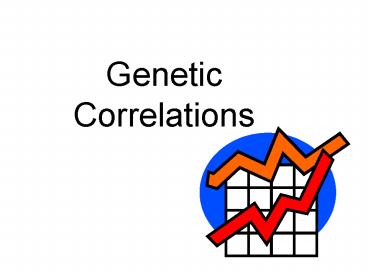Genetic Correlations - PowerPoint PPT Presentation
1 / 29
Title:
Genetic Correlations
Description:
With selection for a phenotype (trait) there are changes that result in ... Correlation parasite resistance (Haemonchus contortus) : reproduction rate ... – PowerPoint PPT presentation
Number of Views:28
Avg rating:3.0/5.0
Title: Genetic Correlations
1
Genetic Correlations
2
Genetic Improvement
Breeding efforts to improve a trait are
real, what happens if an unselected change
results in another trait ?
3
Correlated Responses
With selection for a phenotype (trait) there are
changes that result in unselected traits. How do
you determine if the changes are related ?
4
How do you determine if there is an association
in the response ?
Determine the statistical relationship between
the two traits, correlation coeficient (Pierce
, p 654)
5
Correlation (r) Values, range
-1 to 1
6
Zero Correlation
7
Positive Correlation
8
Negative Correlation
9
P G x E PXY GXY EXY
10
A genetic correlation exists when genes
influence one trait also influence another
trait.
11
Examples of Genotypic (rG) and Phenotypic (rP)
Correlations rG rP Pigs
Growth rate food conversion ratio -.80
-.75 Growth rate food intake .40
.45 Growth rate backfat thickness
-.25 -.10 Feed conversion ratio
backfat thick. .30 .20 Domestic chickens
Egg number age at first egg - .35
- .25 Egg number body weight
- .20 .00 Egg number egg
weight - .30 - .05
Age at first egg body weight .10
.00 Age at first egg egg
weight .15 .10 Body weight
egg weight .40 .33
12
Examples of genetic correlations and phenotypic
correlations for traits in farm animals
13
(No Transcript)
14
Are all correlation coefficients (genetic and
phenotypic) real ?
15
(No Transcript)
16
Real or Significant Correlation
Coefficient Calculated r must gt Table value
with a specified number of df Example Calc. r
.37 with n17 observation, df15 Tabular r _at_
P.05 level .48 Calculated r is not
significant Pgt.05)
17
Degrees of Freedom (df) associated with a
correlation coefficient n-2 n number of
observations, note in chi square, df n-1
18
Having established that a correlation coefficient
is significant............. What is the
importance of the size of the correlation ?
or is it useful?
19
Genoty/Phenoty
Beef cattle BW WW BWG FW YW CMA Birth wt
BW .58 .38 .64 ? Weaning wt
WW .39 .98 .79 .67 ? Birth-wean
gain BWG .23 .97 .73 Final feedlot wt FW
.42 .65 .63 Yearling wt (pasture)
YW .64 Cow maternal ability CMA
20
- Its Application in Selection
- Correlation indicates how changes in 2 traits
will occur - predictive
21
- Its Application in Selection
- Allows for the planning of countermeasures
22
Its Application in Selection
- Use to select for a hard / difficult trait to
measure by selecting for its correlate, indirect
selection. (improving feed efficiency)
23
Example of a Correlations Application Merino
Sheep (Reproduction, wool, meat)
- Correlation parasite resistance (Haemonchus
contortus) reproduction rate - rG in 2 flocks -. 22 . 64
- L1-reprod. not affected with selection for
increased parasite resistance - L2-bred for Hc susceptibility had reduced
fertility. - Accuracy of estimates is important when applied
in breeding
24
- Thus far, discussed how to improve a single
quantitative trait in an animal.... - know the phenotypic trait of interest
- h 2 of the trait
- population size known, SD planned, NE is
appropriate, aware of rGs - How often do we select for a single
phenotypic trait in a population ?
25
Typical situation ........ improvement for
multiple traits simultaneously within an
animal Examples ? - nega. gen. correlation
Butterfat and milk Yield in dairy cattle -- cant
have a breed that has the vol. of a Holstein and
the fat of Jersey
26
- Three Practical Breeding Methods for Selecting
for More Than One Trait - Tandem Selection
- - not recommended too costly in time
- gains decay without contin. sel. press.
- Independent Culling
- - loose superior animals requires large pop. to
select from uncompromising
27
- Three Practical Methods......
- Selection Index
- - Most valued and efficient approach, allows for
partial weakness in the breeders is used for
several traits simultaneously. - I b1X1 b2X2 ............bnXn
- where, Iindex value X trait, and n
adjustment factor for the trait
28
Comparison of Methods for Improving Selection
Response Selection Index gt Independent Culling
gt Tandem Selection
29
Reference Text for Procedures Used to Calculate
Genetic Parameters, rG, h 2, ..... Manual of
Quantitative Genetics by Walter A Becker, 5th
ed. 1992
Deceased



























![Pitfalls in Genetic Association Studies [M.Tevfik DORAK] PowerPoint PPT Presentation](https://s3.amazonaws.com/images.powershow.com/A1261712708BVioU.th0.jpg?_=20141109045)



